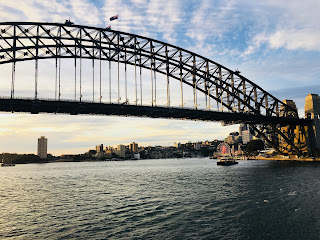For a non-opera person like me to
describe Bizet’s Carmen is a fool’s errand.
All the terminology will be wrong--I’m not sure I know a mezzo-soprano
from a contralto or a tenor from a baritone.
Not having ever seen a production of Carmen performed as the composer originally
intended it, I can only guess at the license taken by the director of this
version. I know the original was set in
Seville, Spain (a country where Bizet had never traveled) and this one
definitely had a Cuban quality to it with the Army grunts resembling Che
Guevara in camouflage and the set design looking like a crumbling Havana square
replete with a 1950’s jalopy. But those caveats aside, let me try to describe
our experience at the Sydney Opera House.
Our seats were perfect—sixth row
left but in full view of the entire stage and portions of the orchestra. We arrived in plenty of time, purchased a
glass of wine and went out on the deck to people watch and marvel at the
building and the surrounding harbor. An
Asian couple had brought their two small children, little boys of about three
and four, who could have been the poster children for Ritalin and both were
having uncontrollable melt-downs both outside the building and inside. Neither the mother nor the father could
control them as they ran around like whirling dervishes. We were horrified that anyone would bring little kids to an opera and took refuge behind the
bar where we met a Danish couple, also shocked at the spectacle, and they
wondered if any of us would be unlucky enough to be seated near these little
hellions. We struck up a lovely conversation with this most interesting couple
who had sold their house a couple of years ago, bought a sailboat and lived on
it for two years before selling it and coming to Australia. We chatted until showtime and miraculously there
were no noisy children once the production began. Perhaps they were asked to leave...
The theatre itself, the Joan
Sutherland, on the main level of the Opera House, is reminiscent of a West End theatre,
all merlot-colored velvet curtains, ornate loges and an Orchestra pit with full
orchestra. Intimate but not too small. Carmen was sung and spoken in the original
French, with translations into Chinese and English subtly placed on small
screens along the periphery of the theatre.
After struggling for a while to watch the action, while keeping up with
the text, I made the decision to concentrate on the production rather than on reading
the translations. Of course no photos were
allowed, thus description based on memory is my only tool.
The sets and lighting are Broadway
quality, and the colorful and exotic costumes are updated to modern times with
even a cell phone and a selfie thrown in to make the point. There is definitely a Cubanesque aura although
the Spanish influence is also clear.
The opening scene introduces us to
our hero Don Jose, a naive young soldier who has run away from his mother and
girlfriend to join the Army in a fit of pique after an argument. We are soon introduced to the girlfriend,
dressed modestly in trench coat and sensible shoes who begs him to come home
and delivers a letter from his mother saying all is forgiven. Oh by the way, Mama is sick, she tells Don
Jose, delivering the ultimate guilt trip in her efforts to lure him back, not
so much to Mama, but to her. But Don
Jose has already met the beautiful and sultry gypsy Carmen who gives him a
flower and he is immediately in love with the wrong woman. Carmen and her coterie of gypsy friends, a
group of zoot-suited smugglers carrying unnamed contraband combine with the
soldiers to produce a colorful and eclectic set.
The somewhat complicated plot
progresses through its inevitable conclusion where Carmen lures Don Jose away
from the Army to “freedom” but soon loses interest when the handsome Toreador comes on the scene. The Toreador song
(Oh Flora-dora, don’t spit on the floor-a...) was worth the price of admission
and I couldn’t help quaking and giggling with delight during it. I noticed that the man next to me had the
same reaction. I wanted to ask him if he
knew the Floradora parody, but I don’t think he spoke English and anyway it would
have exposed me as the dilettante that I am.
Although Carmen ends in tragedy
when Don Jose stabs her in response to her derisive rejection of him, the comedic
aspects of it were always paramount. A
troop of very talented young boys had singing and dancing parts and made us
laugh at their gymnastic flips and headstands all the while singing in French.
The choreography of the show was astounding—Broadway quality—and again I wonder
if Bizet wrote that into his original plan.
The costuming is glorious--colorful
flamenco style dresses, and suits for the men in every hue. My favorite was the shiny red one worn by
Escamillo, the Toreador, when he wasn’t wearing his bullfighting garb. The zoot suit look worn by the smugglers
contrasts effectively with the Castro Army drab of the soldiers.
Passion, drama, comedy, tragedy, shock,
tenderness, are all present in this extravagant production. I came away with all expectations exceeded
and maybe we will take up opera back in Dallas.
Afterwards we meandered slowly back to the hotel with fireworks to serenade us and the Chinese New Year blow-ups brilliantly aglow.
 |
| This is the Year of the Dog who holds the place of honor in front of the Opera House. |
 |
| Inside the Joan Sutherland Theatre |
 |
| This is from the playbill but it will give you some idea of the colorful costumes. Don Escamillo, the bullfighter. |
Fireworks after the opera!
 |
| Everything looks more enchanting at night. |























